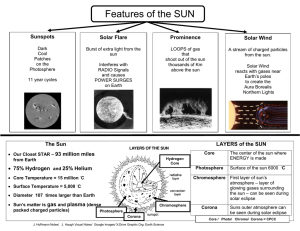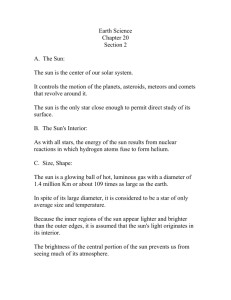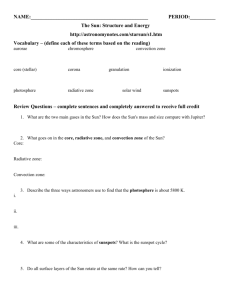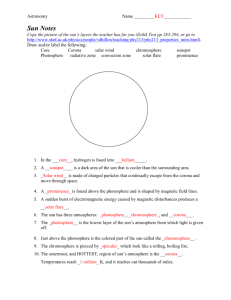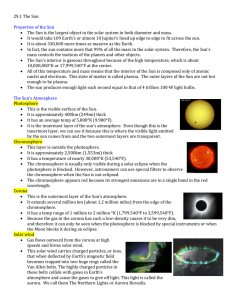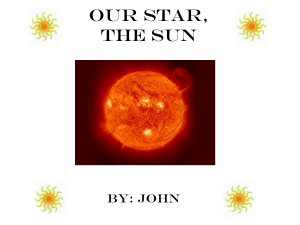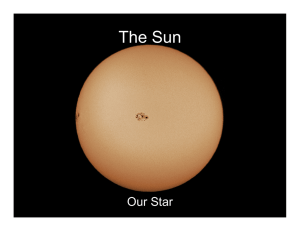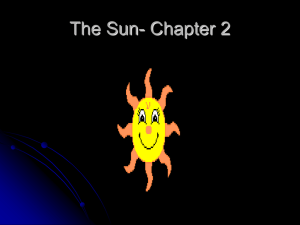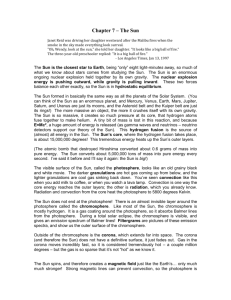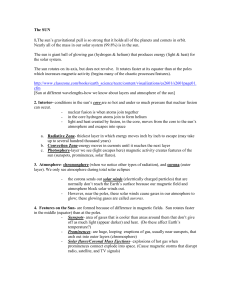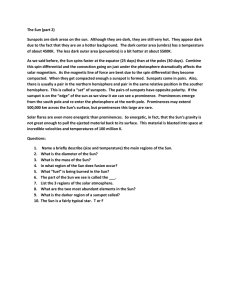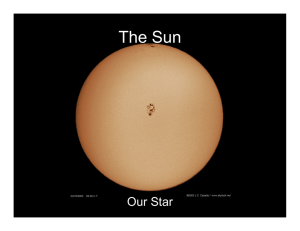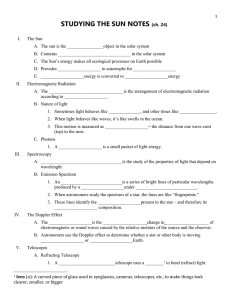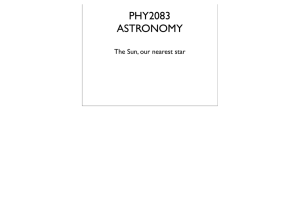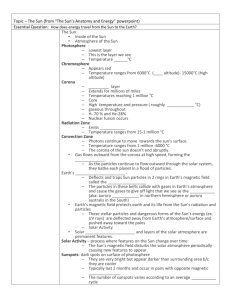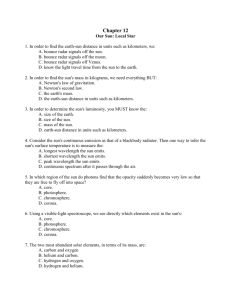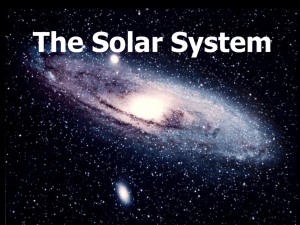Sun`s rap song
advertisement
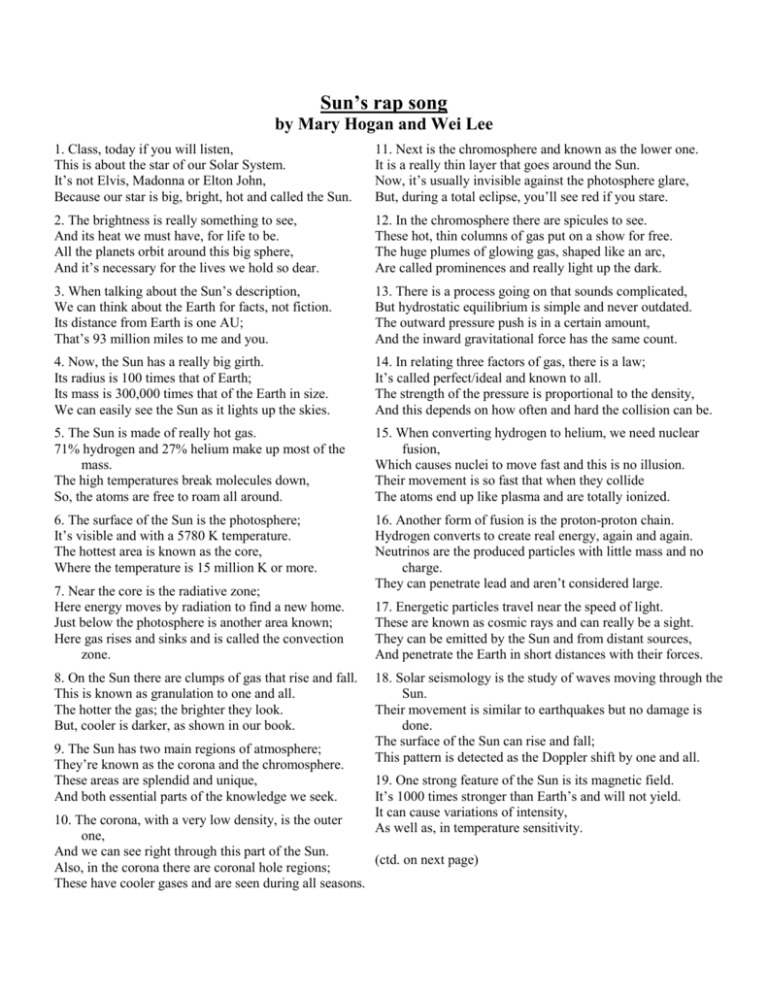
Sun’s rap song by Mary Hogan and Wei Lee 1. Class, today if you will listen, This is about the star of our Solar System. It’s not Elvis, Madonna or Elton John, Because our star is big, bright, hot and called the Sun. 11. Next is the chromosphere and known as the lower one. It is a really thin layer that goes around the Sun. Now, it’s usually invisible against the photosphere glare, But, during a total eclipse, you’ll see red if you stare. 2. The brightness is really something to see, And its heat we must have, for life to be. All the planets orbit around this big sphere, And it’s necessary for the lives we hold so dear. 12. In the chromosphere there are spicules to see. These hot, thin columns of gas put on a show for free. The huge plumes of glowing gas, shaped like an arc, Are called prominences and really light up the dark. 3. When talking about the Sun’s description, We can think about the Earth for facts, not fiction. Its distance from Earth is one AU; That’s 93 million miles to me and you. 13. There is a process going on that sounds complicated, But hydrostatic equilibrium is simple and never outdated. The outward pressure push is in a certain amount, And the inward gravitational force has the same count. 4. Now, the Sun has a really big girth. Its radius is 100 times that of Earth; Its mass is 300,000 times that of the Earth in size. We can easily see the Sun as it lights up the skies. 14. In relating three factors of gas, there is a law; It’s called perfect/ideal and known to all. The strength of the pressure is proportional to the density, And this depends on how often and hard the collision can be. 5. The Sun is made of really hot gas. 71% hydrogen and 27% helium make up most of the mass. The high temperatures break molecules down, So, the atoms are free to roam all around. 15. When converting hydrogen to helium, we need nuclear fusion, Which causes nuclei to move fast and this is no illusion. Their movement is so fast that when they collide The atoms end up like plasma and are totally ionized. 6. The surface of the Sun is the photosphere; It’s visible and with a 5780 K temperature. The hottest area is known as the core, Where the temperature is 15 million K or more. 16. Another form of fusion is the proton-proton chain. Hydrogen converts to create real energy, again and again. Neutrinos are the produced particles with little mass and no charge. They can penetrate lead and aren’t considered large. 7. Near the core is the radiative zone; Here energy moves by radiation to find a new home. Just below the photosphere is another area known; Here gas rises and sinks and is called the convection zone. 8. On the Sun there are clumps of gas that rise and fall. This is known as granulation to one and all. The hotter the gas; the brighter they look. But, cooler is darker, as shown in our book. 9. The Sun has two main regions of atmosphere; They’re known as the corona and the chromosphere. These areas are splendid and unique, And both essential parts of the knowledge we seek. 17. Energetic particles travel near the speed of light. These are known as cosmic rays and can really be a sight. They can be emitted by the Sun and from distant sources, And penetrate the Earth in short distances with their forces. 18. Solar seismology is the study of waves moving through the Sun. Their movement is similar to earthquakes but no damage is done. The surface of the Sun can rise and fall; This pattern is detected as the Doppler shift by one and all. 19. One strong feature of the Sun is its magnetic field. It’s 1000 times stronger than Earth’s and will not yield. It can cause variations of intensity, As well as, in temperature sensitivity. 10. The corona, with a very low density, is the outer one, And we can see right through this part of the Sun. (ctd. on next page) Also, in the corona there are coronal hole regions; These have cooler gases and are seen during all seasons. 20. The variations of intensity are indicated by sunspots. They appear due to cooler gases making darker dots. Another magnetic disturbance is known as a solar flare. It’s a brief and bright eruption, that is not rare. 21. The heat flow in a magnetic field can be reduced, And from cooler gas prominences are produced. Due to less pressure inside and hotter gas outside, Huge, glowing plumes, shaped like an arc, can abide. 22. Solar wind is an outflow of hot, low density gases. It flows from the upper solar atmosphere and then passes. Carried along are small bits of material, lost from the Sun. When gas and blowing dust combine, the comet’s tail is done 23. The Zeeman effect is a physical process of a magnetic field, This causes the spectrum lines to split and to yield. They become 1, 2, 3 or more components and are committed. The electron orbits and light waves altered when emitted. 24. There is a solar cycle that can change from year to year. The activity of sunspots and solar flares is tracked here. Due to differential rotation their numbers rise and fall, And so the cycle period of 11 years is known to one and all. 25. Now, between 1645 and 1715 there were few sunspots; However, before and after there were lots and lots. The solar cycle just switched off, a man insisted, So the Maunder minimum is how the period is listed. 26. Well, we’re at the end of this rap and it’s time to go, But we’ve learned that the Sun can really put on a show. There are still a lot of things not really known yet, So, for now, just sit back and enjoy a beautiful sunset.
